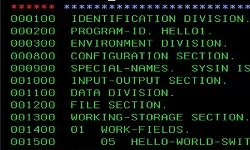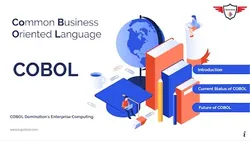
IBM COBOL Software Development Process 
This course provides an introduction to IBM COBOL and the Software Development Lifecycle (SDLC). Participants will gain knowledge and hands-on experience with core concepts and technologies, including life cycle and systems analysis, design, and structured coding. ▼
ADVERTISEMENT
Course Feature
![]() Cost:
Cost:
Free
![]() Provider:
Provider:
Coursera
![]() Certificate:
Certificate:
Paid Certification
![]() Language:
Language:
English
![]() Start Date:
Start Date:
22nd May, 2023
Course Overview
❗The content presented here is sourced directly from Coursera platform. For comprehensive course details, including enrollment information, simply click on the 'Go to class' link on our website.
Updated in [February 21st, 2023]
Learners can learn about IBM, COBOL, and mainframe computing from this course. They will gain an understanding of the Software Development Lifecycle (SDLC) and its core concepts and technologies. This includes life cycle and systems analysis concepts, design and structured coding, and a wide variety of topics. Learners will also gain hands-on experience with the topics covered in the course, allowing them to apply their knowledge in a practical setting. Finally, the course will provide learners with the requisite working knowledge and practical experience to help them succeed in their software development endeavors.
[Applications]
Participants will have a better understanding of the IBM COBOL Software Development Process and be able to apply the concepts and technologies learned to their own projects. Suggestions for application of this course include:
1. Utilizing the knowledge gained to develop and maintain COBOL applications.
2. Applying the SDLC concepts to create and manage software development projects.
3. Understanding the fundamentals of mainframe computing and how to use it to develop and maintain applications.
4. Utilizing the knowledge gained to create and maintain databases.
5. Applying the concepts and technologies learned to create and maintain web applications.
6. Understanding the fundamentals of systems analysis and design and how to use it to develop and maintain applications.
7. Utilizing the knowledge gained to create and maintain user interfaces.
8. Applying the concepts and technologies learned to create and maintain distributed applications.
[Career Paths]
1. Mainframe Developer: Mainframe developers are responsible for developing, testing, and maintaining software applications on IBM mainframe systems. They use COBOL and other programming languages to create and modify programs, and they must be familiar with the IBM mainframe environment. Mainframe developers must also be able to troubleshoot and debug programs, and they must be able to work with other developers and IT professionals to ensure that applications are running smoothly. The demand for mainframe developers is increasing as more organizations are relying on mainframe systems for their data processing needs.
2. Systems Analyst: Systems analysts are responsible for analyzing the needs of an organization and developing solutions to meet those needs. They must be familiar with the IBM mainframe environment and be able to use COBOL and other programming languages to create and modify programs. Systems analysts must also be able to troubleshoot and debug programs, and they must be able to work with other developers and IT professionals to ensure that applications are running smoothly. The demand for systems analysts is increasing as more organizations are relying on mainframe systems for their data processing needs.
3. Database Administrator: Database administrators are responsible for managing and maintaining databases on IBM mainframe systems. They must be familiar with the IBM mainframe environment and be able to use COBOL and other programming languages to create and modify programs. Database administrators must also be able to troubleshoot and debug programs, and they must be able to work with other developers and IT professionals to ensure that applications are running smoothly. The demand for database administrators is increasing as more organizations are relying on mainframe systems for their data processing needs.
4. Business Analyst: Business analysts are responsible for analyzing the needs of an organization and developing solutions to meet those needs. They must be familiar with the IBM mainframe environment and be able to use COBOL and other programming languages to create and modify programs. Business analysts must also be able to troubleshoot and debug programs, and they must be able to work with other developers and IT professionals to ensure that applications are running smoothly. The demand for business analysts is increasing as more organizations are relying on mainframe systems for their data processing needs.
[Education Paths]
1. Bachelor of Science in Computer Science: This degree program provides students with a comprehensive understanding of computer science, including programming languages, software engineering, computer architecture, and operating systems. Students will learn the fundamentals of computer science, as well as the latest trends in software development, such as artificial intelligence, machine learning, and cloud computing.
2. Bachelor of Science in Information Technology: This degree program focuses on the application of technology to solve business problems. Students will learn the fundamentals of computer programming, database management, network security, and web development. They will also gain an understanding of the latest trends in information technology, such as cloud computing, big data, and mobile application development.
3. Master of Science in Software Engineering: This degree program provides students with an in-depth understanding of software engineering principles and practices. Students will learn the fundamentals of software design, development, and testing, as well as the latest trends in software engineering, such as agile development, DevOps, and microservices.
4. Master of Science in Computer Science: This degree program provides students with an advanced understanding of computer science, including programming languages, software engineering, computer architecture, and operating systems. Students will learn the fundamentals of computer science, as well as the latest trends in software development, such as artificial intelligence, machine learning, and cloud computing.
Pros & Cons

Interesting course.

Valuable certification.

Good readings.

Content needs updating.

Confusing assignments.

Little programming practice.
Course Provider

Provider Coursera's Stats at AZClass
Discussion and Reviews
0.0 (Based on 0 reviews)
Explore Similar Online Courses

LINQ Fundamentals in C# 10

Gathering Data into Power BI

Python for Informatics: Exploring Information

Social Network Analysis

Introduction to Systematic Review and Meta-Analysis

The Analytics Edge

DCO042 - Python For Informatics

Causal Diagrams: Draw Your Assumptions Before Your Conclusions

Whole genome sequencing of bacterial genomes - tools and applications

Mainframe COBOL Tutorial

COBOL


Start your review of IBM COBOL Software Development Process